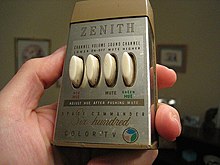Robert Adler
Robert Adler | |
|---|---|
 Robert Adler | |
| Born | December 4, 1913 |
| Died | February 15, 2007 (aged 93) |
| Nationality | American -Austrian |
| Alma mater | University of Vienna |
| Known for | wireless remote control for televisions |
| Awards | Edison Medal (1980) |
| Scientific career | |
| Fields | Physics |
| Institutions | Zenith Electronics |
| Doctoral students | None |
Robert Adler (December 4, 1913 – February 15, 2007) was an Austrian-born American inventor who held numerous patents. He worked for Zenith retiring as the company's Vice President and Director of Research. His work included developing early sound based remote controls for televisions, which were the standard for 25 years until replaced by IR remotes that could transmit more complex commands.
Achievements
Adler was born in Vienna in 1913, the son of Jenny (née Herzmark), a doctor, and Max Adler, a social theorist.[1][2][3] He earned a Ph.D. in Physics from the University of Vienna in 1937. Following Austria's annexation by Nazi Germany in 1939, Dr. Adler, who was Jewish[citation needed], left the country. He traveled first to Belgium, then to England, where he acted on the advice of friends, who recommended that he emigrate to the United States.[4] After emigrating to the United States, he began working at Zenith Electronics in the research division in 1941. In his lifetime, Adler was granted 58 US patents.
Contributions to the remote control
The invention Adler is best known for is the wireless remote control for televisions. While not the first remote control, its underlying technology was a vast improvement over previous remote control systems.
The "Zenith Flash-Matic" remote control, invented by Eugene Polley, another engineer at Zenith, was the first wireless remote control, replacing the signal cable based remote control devices, which never were a success. The Flash-Matic used directional flashlight in the transmitter device, and photo cells in the television set itself. One of the major shortcomings of this technology was that if the television set was exposed to direct sunlight, it could inadvertently trigger one of the remote control functions. The company president sent the engineers back to the drawing board to come up with a better solution.

A system based on radio waves was briefly considered but rejected because the signals could easily travel through walls and could inadvertently change the channel on a neighbor's television. Furthermore, the marketing people at Zenith desired a remote control which did not require batteries, as it was perceived at the time that if the battery died, the customer might think something was wrong with the television set itself.
Adler's solution was to use sound waves to transmit signals to the TV. The first remote control he developed, the "Space Command", used aluminum rods, analogous to tuning forks, struck by hammers toggled by the buttons on the device, to produce high-frequency tones that would be interpreted to control functions on the television set.
In the 1960s, Adler modified the remote control to use ultrasonic signals, a technology which went on to be used in television sets manufactured for the next 25 years, until replaced by infrared systems which could transmit more complex commands (but, alas, require batteries to run).
Professional accomplishments
By the time of his retirement from Zenith, officially in 1982, Adler was the company's Vice President and Director of Research. He remained a technical advisor to Zenith until 1999. In 1980, Adler was awarded the Edison Medal. In 1997, Adler and Polley were jointly awarded an Emmy Award by the National Academy of Television Arts and Sciences. Adler's latest patent application was filed on October 6, 2006 for work on touch-screen technology.[5]
Death
Robert Adler died in a Boise, Idaho nursing home of heart failure at age 93 years old.
References
- ^ "The New York Times". nytimes.com. Retrieved 2015-06-20.
- ^ Lane, A.T. (1995). Biographical Dictionary of European Labor Leaders. Vol. 1. Greenwood Press. p. 8. ISBN 9780313264566. Retrieved 2015-06-20.
- ^ http://familytreemaker.genealogy.com/users/j/o/h/Marshall-John/WEBSITE-0001/UHP-0210.html
- ^ "Inventor of Remote Control: Robert Adler". inventorspot.com. Retrieved 2015-06-20.
- ^ http://appft1.uspto.gov/netacgi/nph-Parser?Sect1=PTO1&Sect2=HITOFF&d=PG01&p=1&u=%2Fnetahtml%2FPTO%2Fsrchnum.html&r=1&f=G&l=50&s1=%2220070024599%22.PGNR.&OS=DN/20070024599&RS=DN/20070024599
External links
- Inventor of the Week Archive - Robert Adler
- Robert Adler at The Interviews: An Oral History of Television
- Robert Adler: Biography of the Inventor Who Made Life Easier for Couch Potatoes
- Man who glued TV watchers to the couch dies
- The Inventor Who Deserves a Sitting Ovation - The Washington Post
- Robert Adler, 94; Engineer, Co-Inventor of TV Remote Control - The Washington Post
- Obituary, The Independent, 22 February 2007
- Obituary, The Daily Telegraph, 13 March 2007
- Obituary and Archive of American Television interview description
- Biography from IEEE
